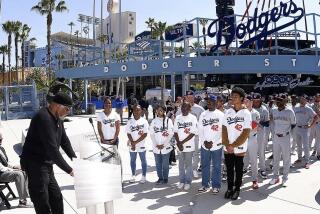Charlie Sifford broke barriers, but no one broke his spirit
- Share via
History heals. That’s what they say. It’s been 50 years since Charlie Sifford broke golf’s color barrier, and there’s no way he can still be hurting.
The pioneer with a blue handkerchief in his suit pocket and tortoise-shell cane on his lap is filling a bland hotel conference room with sweet reflections. He is calmly explaining how his difficult life was a necessary journey, softly talking about how he’s 89 and too old for grudges.
History heals. And then, suddenly, history bleeds.
You ask him about golf’s most fabled course, it’s most revered tournament, which happens to be the one hurdle he could not leap, the one line he never crossed, and suddenly Charlie Sifford is fighting again.
“[Bleep] Augusta,” he says. “When I was good enough to play there, the Masters never invited me, so why would they invite me now?”
He shakes his head and from somewhere deep, the bitterness rises.
“I could have been invited, I should have been invited, but a long time ago they thought all golfers should be white and all caddies should be black,” he says. “I’ve never been to Augusta and I’m never going.”
Maybe history doesn’t always heal. Maybe if Charlie Sifford ever forgets, the rest of us can never remember.
“I was going to play golf, and the hell with everything else,” he says, and maybe that’s what we’re supposed to hear.
Sifford, who will be inducted Tuesday into the Southern California Golf Assn. Hall of Fame, spoke Monday in tones that were as caustic as they were conciliatory. Amid his contentment there are still scars, there is still pain, still so much to pass down.
One moment he says, “I’ve lived a damn good life. I only have a few little years left, and I want to spend it happy.”
The next moment he says, “I’m not sure about everybody calling me the Jackie Robinson of golf, because Jackie Robinson had a team behind him, and I had to do it alone.”
Sifford followed in Robinson’s path by becoming the first African American to become an official member of the PGA in 1961. But, indeed, the similarities ended there.
Robinson had the public backing of the Brooklyn Dodgers — remember Pee Wee Reese draping an arm around him in Cincinnati? — while Sifford did it alone, fighting weekly battles from heckling crowds and ignorant officials.
Once, while pulling a pin, he realized that the cup had been filled with feces. Several times spectators kicked his ball through the rough. Other times he would find his ball buried under trash.
“Nothing bothered me, nothing stopped me,” Sifford says. “I wasn’t just trying to do this for me, I was trying to do it for the world.”
Robinson’s impact led to increased diversity in major league baseball, such that, in 1995, 19% of the players were black, a figure that has dropped to 8.5% today.
Sifford’s impact essentially has been limited to Tiger Woods, as today Woods and rookie Joseph Bramlett are the only two golfers on tour of African American descent.
“This was just never a black man’s game,” says Sifford. “It’s just too hard, too expensive. You can’t just walk out off a caddie pen and play; you have to go to college. It’s too much for most African American kids.”
Robinson, finally, is remembered every summer night in every major league park where they are playing baseball.
Sifford, meanwhile, wonders sometimes how much he even matters. In 2004, he became the first African American inducted into the World Golf Hall of Fame, the highlight of his career. But he rarely hears from those who are trying to follow in his footsteps. Bramlett, 23, played in 25 PGA Tour events this summer, which wouldn’t have been possible without Sifford, but the men have never met.
“I hate to make this statement, but I rarely get any compliments or thank-you for what you’ve done,” Sifford said. “Joseph Bramlett? Who is he?”
While Sifford still occasionally speaks to Woods, and is pleased with the respect Woods gives him, he wonders if his protégé will ever be a great golfer again.
“He made a mistake, everyone makes mistakes, but now he’s got to get his life straightened out a little bit,” he says. “He had the world by the tail and messed it up.”
Sifford is being honored this week by Southern California golfers because, among other things, one of his three career tournament wins was the Los Angeles Open at Rancho Park in 1969. He also won the Long Beach Open in 1957 after moving here because area tournaments allowed blacks.
“Los Angeles was always so good to me,” says Sifford, who for years owned and lived in an apartment complex at Crenshaw and 11th Avenue. “I could play anywhere here. I will never forget that.”
Hobbled by an arthritic right knee, he doesn’t play much of anywhere these days. He and buddies will ride courses in Charlotte, N.C., his hometown, but he gets out only for the occasional swing.
“I can still putt,” he says, smiling. “If only I could get it to the green.”
As he hobbles slowly to a photo session Monday, he is jokingly asked if he could use that cane to putt.
“I could use this cane for a lot of things,” he says. “I have been spicy all my life, and I’m not going to stop now.”
Charlie Sifford continues down the hotel hallway with that cane, laughing harshly through the comfortable silence, pushing and prodding forever.
More to Read
Go beyond the scoreboard
Get the latest on L.A.'s teams in the daily Sports Report newsletter.
You may occasionally receive promotional content from the Los Angeles Times.











